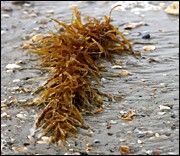Whether you accept it, avoid it or live somewhere in between, insurance coverage has become a defining issue for our profession. Patients increasingly expect to use their benefits, practitioners want to be compensated fairly for their time and expertise, and the system itself remains – at best – fragmented. The encouraging news is that coverage has expanded in meaningful ways. The challenging news is that reimbursement, across the board, remains inadequate.
Herbs & Botanicals
Seaweed (hai zao)
What is seaweed? What is it used for?
While many people consider kelp and seaweed to be synonymous, this is actually not the case. Kelp is technically a type of seaweed, but other forms of seaweed are not kelp. Sea weed is the name given to various forms of algae, which range in color from red to green to brown.
Most seaweed grows in shallow water (less than 150 feet deep), although some also grow in tidal areas. The type of seaweed that grows in a coastal area's high-water mark is different than the type of seaweed that grows at lower levels.Although they are also grown in China, seaweed is extremely popular in Japan; in fact, most varieties of seaweed are known primarily by their Japanese names, such as nori, arame, dulse, kombu and wakame. The most well-known of these is nori, which turns dark green when cooked, and is used world wide in sushi making. Other forms of seaweed are used in soups and salads.
 In addition to its culinary uses, seaweed is an important medicinal. Most seaweed is high in vitamin B12 and iodine. Other minerals found in seaweed include copper, iron, magnesium, calcium, potassium, and zinc. Because seaweed contains all of these nutrients, it is sometimes referred to as "nature's treasure chest."
In addition to its culinary uses, seaweed is an important medicinal. Most seaweed is high in vitamin B12 and iodine. Other minerals found in seaweed include copper, iron, magnesium, calcium, potassium, and zinc. Because seaweed contains all of these nutrients, it is sometimes referred to as "nature's treasure chest."
Seaweed has salty and cold properties, and is associated with the Liver, Stomach and Kidney meridians, according to the precepts of traditional Chinese medicine. It helps to treat skin and glandular conditions such as iodine deficiency, goiter and scrofula; reduces the incidence of edema; and is effective against bronchitis and coughs. It also helps blood cells to coagulate, and may inhibit the growth of some types of cancerous tumors.
How much seaweed should I take?
The amount of seaweed to be taken depends on the condition being treated. Generally, many practitioners will recommend between 4.5 and 15 grams of dried seaweed, ground up into a decoction with boiling water.
What forms of seaweed are available?
Seaweed is available in a wide variety of forms, ranging from thin, dried sheets to powders, pills and capsules. It can be purchased at most supermarkets, along with nutrition stores, herbal shops and Asian markets.
What can happen if I take too much seaweed? Are there any interactions I should be aware of? What precautions should I take?
Seaweed appears to counteract the properties of licorice root. As a result, seaweed and licorice root should not be taken together or combined as part of a larger herbal formula. In addition, it should be used with caution by patients diagnosed with deficiency of spleen qi or stomach qi.
Because seaweed appears to help blood cells coagulate, it should be used with caution by patients taking blood-thinning medications. As always, make sure to consult with a licensed health care provider before taking seaweed or any other herbal remedy or dietary supplement.
References
- Chen JK, Chen TT. Chinese Medical Herbology and Pharmacology. City of Industry, CA: Art of Medicine Press, 2004, pp. 715-716.
- Cui ZM. Treating 116 cases of hyperplasia of prostate with modified gui zhi fu ling tang. Henan Journal of TCM Pharmacy 1999;14(4):44.
- Hsu HY. Treating Cancer With Chinese Herbs. Long Beach, CA: Oriental Healing Arts Institute, 1990.
- Ji YB, Gao SY, Zhang XJ. Influence of sargassum fusiforme polysaccharide on apoptosis of tumor cells. Zhongguo Zhong Yao Za Zhi March 2004;29(3):245-7.
- Teas J, Hebert JR, Fritton JH, et al. Algae -- a poor man's HAART? Med Hypotheses 2004;62(4):507-10.


